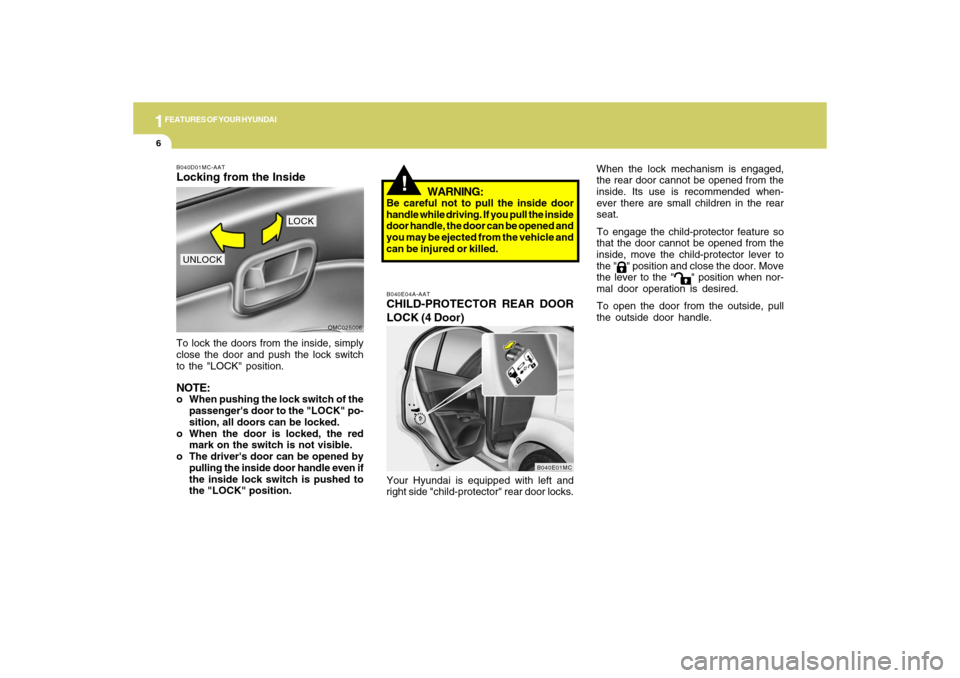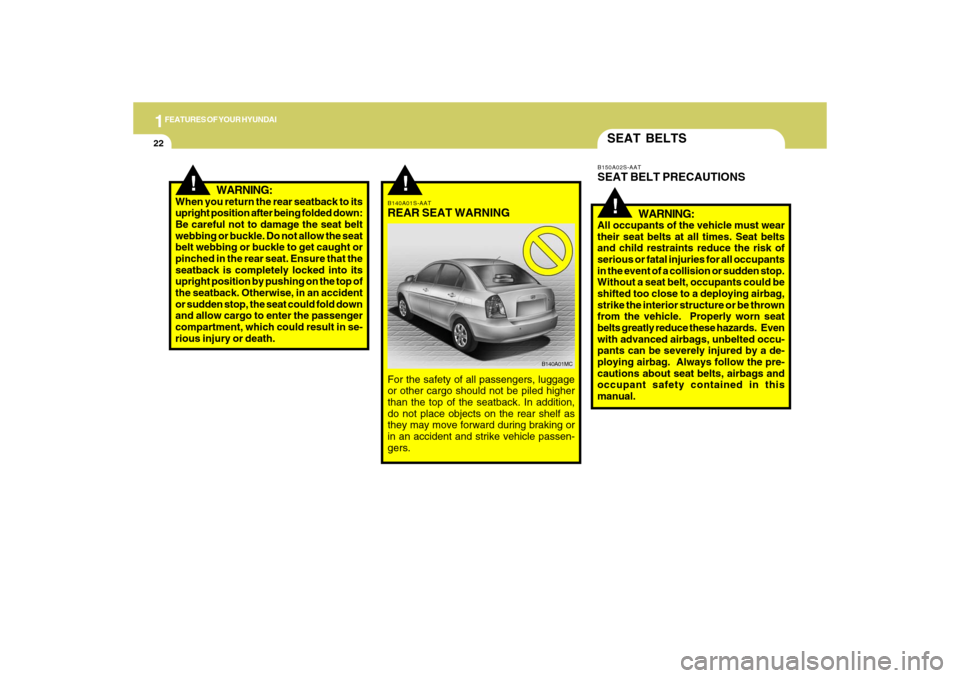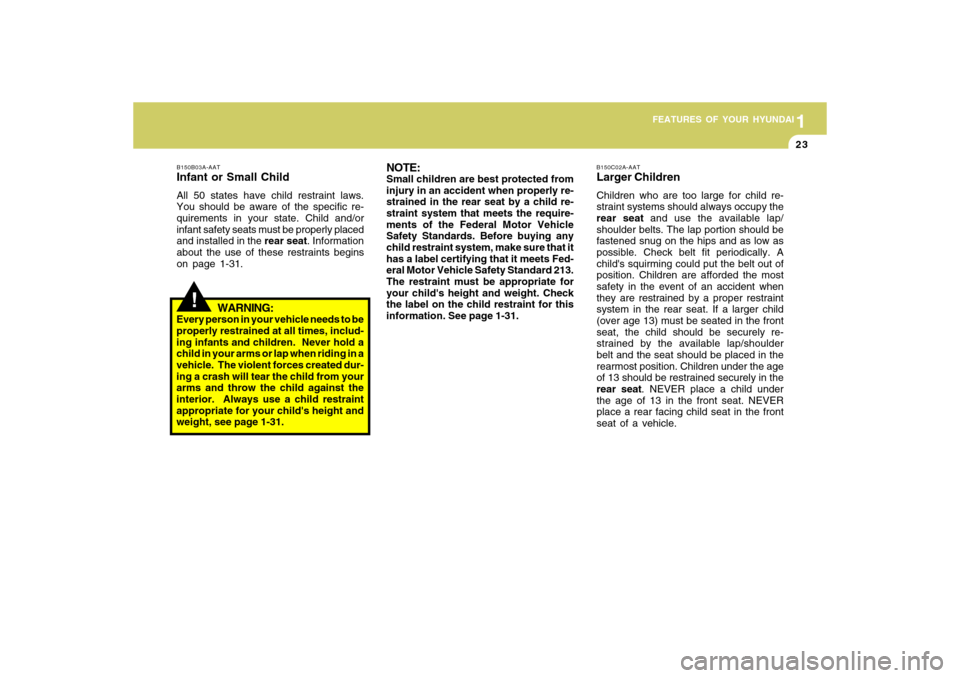2009 Hyundai Accent child seat
[x] Cancel search: child seatPage 11 of 266

FEATURES OF YOUR HYUNDAI
1
Fuel Recommendations ................................................ 1-2
Breaking in Your New Hyundai .................................... 1-3
Keys.............................................................................. 1-4
Door Locks ................................................................... 1-4
Theft-Alarm System ...................................................... 1-8
Window Glass ............................................................1-11
Seats...........................................................................1-13
Seat Belts...................................................................1-22
Child Restraint System...............................................1-31
Advanced Supplemental Restraint (AIRBAG)
System......................................................................1-41
Instrument Cluster and Indicator Lights .....................1-60
Warning and Indicator Lights ......................................1-64
Trip Computer.............................................................1-73
Multi-Function Light Switch .........................................1-76
Windshield Wiper and Washer Switch.......................1-78
Sunroof.......................................................................1-84
Mirror...........................................................................1-89
Hood Release.............................................................1-93
Cruise Control System.............................................1-101
Heating and Cooling Control.................................... 1-106
Stereo Sound System..............................................1-117
Antenna.....................................................................1-119
Audio System...........................................................1-120
1
Page 14 of 266

1FEATURES OF YOUR HYUNDAI4
DOOR LOCKS!
B030B01NF-GATRecord Your Key NumberA code number is recorded on the num-
ber tag that came with the keys to your
Hyundai. This key number tag should not
be left with the keys but kept in a safe
place, not in the vehicle. The key number
should also be recorded in a place where
it can be found in an emergency.
If you need additional keys, or if you
should lose your keys, your authorized
Hyundai dealer can make new keys if you
can supply the key number.
B030B01MCB040A01A-AAT
WARNING:
o Unlocked doors can be dangerous.
Before you drive away (especially if
there are children in the car), be sure
that all the doors are securely closed
and locked so that the doors cannot
be opened from the inside. This helps
ensure that the doors will not be
opened accidentally. Also, when com-
bined with the proper use of seat
belts, locking the doors helps keep
occupants from being ejected from
the car in case of an accident.
o Before opening the door, always look
for and avoid oncoming traffic.
KEYSB030A01A-AATFor greater convenience, the same key
operates all the locks in your Hyundai.
However, because the doors can be
locked without a key, carrying a spare key
is recommended in case you accidentally
lock one key inside the car.
OMC025001
Page 16 of 266

1FEATURES OF YOUR HYUNDAI6
!
B040D01MC-AATLocking from the InsideTo lock the doors from the inside, simply
close the door and push the lock switch
to the "LOCK" position.NOTE:o When pushing the lock switch of the
passenger's door to the "LOCK" po-
sition, all doors can be locked.
o When the door is locked, the red
mark on the switch is not visible.
o The driver's door can be opened by
pulling the inside door handle even if
the inside lock switch is pushed to
the "LOCK" position.
B040E04A-AATCHILD-PROTECTOR REAR DOOR
LOCK (4 Door)Your Hyundai is equipped with left and
right side "child-protector" rear door locks.
OMC025006
UNLOCK
LOCK
B040E01MC
WARNING:
Be careful not to pull the inside door
handle while driving. If you pull the inside
door handle, the door can be opened and
you may be ejected from the vehicle and
can be injured or killed.When the lock mechanism is engaged,
the rear door cannot be opened from the
inside. Its use is recommended when-
ever there are small children in the rear
seat.
To engage the child-protector feature so
that the door cannot be opened from the
inside, move the child-protector lever to
the "
" position and close the door. Move
the lever to the "
" position when nor-
mal door operation is desired.
To open the door from the outside, pull
the outside door handle.
Page 32 of 266

1FEATURES OF YOUR HYUNDAI22
SEAT BELTS
B140A01S-AATREAR SEAT WARNINGFor the safety of all passengers, luggage
or other cargo should not be piled higher
than the top of the seatback. In addition,
do not place objects on the rear shelf as
they may move forward during braking or
in an accident and strike vehicle passen-
gers.
B140A01MC
!
!
B150A02S-AATSEAT BELT PRECAUTIONS
WARNING:All occupants of the vehicle must wear
their seat belts at all times. Seat belts
and child restraints reduce the risk of
serious or fatal injuries for all occupants
in the event of a collision or sudden stop.
Without a seat belt, occupants could be
shifted too close to a deploying airbag,
strike the interior structure or be thrown
from the vehicle. Properly worn seat
belts greatly reduce these hazards. Even
with advanced airbags, unbelted occu-
pants can be severely injured by a de-
ploying airbag. Always follow the pre-
cautions about seat belts, airbags and
occupant safety contained in this
manual.
!
WARNING:
When you return the rear seatback to its
upright position after being folded down:
Be careful not to damage the seat belt
webbing or buckle. Do not allow the seat
belt webbing or buckle to get caught or
pinched in the rear seat. Ensure that the
seatback is completely locked into its
upright position by pushing on the top of
the seatback. Otherwise, in an accident
or sudden stop, the seat could fold down
and allow cargo to enter the passenger
compartment, which could result in se-
rious injury or death.
Page 33 of 266

1
FEATURES OF YOUR HYUNDAI
231
FEATURES OF YOUR HYUNDAI
23
!
B150B03A-AATInfant or Small ChildAll 50 states have child restraint laws.
You should be aware of the specific re-
quirements in your state. Child and/or
infant safety seats must be properly placed
and installed in the rear seat. Information
about the use of these restraints begins
on page 1-31.
WARNING:
Every person in your vehicle needs to be
properly restrained at all times, includ-
ing infants and children. Never hold a
child in your arms or lap when riding in a
vehicle. The violent forces created dur-
ing a crash will tear the child from your
arms and throw the child against the
interior. Always use a child restraint
appropriate for your child's height and
weight, see page 1-31.
NOTE:Small children are best protected from
injury in an accident when properly re-
strained in the rear seat by a child re-
straint system that meets the require-
ments of the Federal Motor Vehicle
Safety Standards. Before buying any
child restraint system, make sure that it
has a label certifying that it meets Fed-
eral Motor Vehicle Safety Standard 213.
The restraint must be appropriate for
your child's height and weight. Check
the label on the child restraint for this
information. See page 1-31.
B150C02A-AATLarger ChildrenChildren who are too large for child re-
straint systems should always occupy the
rear seat and use the available lap/
shoulder belts. The lap portion should be
fastened snug on the hips and as low as
possible. Check belt fit periodically. A
child's squirming could put the belt out of
position. Children are afforded the most
safety in the event of an accident when
they are restrained by a proper restraint
system in the rear seat. If a larger child
(over age 13) must be seated in the front
seat, the child should be securely re-
strained by the available lap/shoulder
belt and the seat should be placed in the
rearmost position. Children under the age
of 13 should be restrained securely in the
rear seat. NEVER place a child under
the age of 13 in the front seat. NEVER
place a rear facing child seat in the front
seat of a vehicle.
Page 34 of 266

1FEATURES OF YOUR HYUNDAI24
!
B150F01A-AATOne Person Per BeltTwo people (including children) should
never attempt to use a single seat belt.
This could increase the severity of inju-
ries in case of an accident.B150G02A-AATDo Not Lie DownTo reduce the chance of injuries in the
event of an accident and to achieve maxi-
mum effectiveness of the restraint sys-
tem, all passengers should be sitting up
and the front seats should be in an up-
right position when the car is moving. A
seat belt cannot provide proper protec-
tion if the person is lying down in the rear
seat or if the front seat is in a reclined
position.
WARNING:
Riding with a reclined seatback in-
creases your chance of serious or fatal
injuries in the event of a collision or
sudden stop. The protection of your
restraint system (seat belts and airbags)
is greatly reduced by reclining your seat.
Seat belts must be snug against your
hips and chest to work properly. The
more the seatback is reclined, the greater
the chance that an occupant's hips will
slide under the lap belt causing serious
internal injuries or the occupant's neck
could strike the shoulder belt. Drivers
and passengers should always sit well
back in their seats, properly belted (see
page 1-26), and with the seatbacks up-
right.
B150D01A-AATPregnant WomenThe use of a seat belt is recommended for
pregnant women to lessen the chance of
injury in an accident. When a seat belt is
used, the lap belt portion should be
placed as low and snugly as possible on
the hips, not across the abdomen. For
specific recommendations, consult a phy-
sician.B150E01A-AATInjured PersonA seat belt should be used when an
injured person is being transported. When
this is necessary, you should consult a
physician for recommendations.
Page 37 of 266

1
FEATURES OF YOUR HYUNDAI
271
FEATURES OF YOUR HYUNDAI
27
NOTE:If the seat belt is not fastened when the
ignition key is turned from the "OFF"
position to the "ON" position, the seat
belt warning will activate to remind the
driver to fasten the seat belt as follows.The driver's seat belt warning light and
chime will activate to the following table
when the ignition switch is in "ON" posi-
tion.
B265E01MC-AAT
Seat Belt Warning Light
and ChimeConditions Warning Pattern
Seat BeltVehicle SpeedLight-Blink Chime-SoundUnbuckled
Buckled
Buckled
→ →→ →
→ Unbuckled
UnbuckledAbove 6mph
(10 km/h)
↓
Below 3mph
(5 km/h)6 seconds
6 seconds
6 seconds *1)
↓Stop *2)
6 secondsNone
B190A03A-AATSEAT BELTS-Front Passenger and
Rear Seat 3-Point System with Com-
bination Locking Retractor :
To Fasten Your BeltCombination retractor type seat belts are
installed in the rear seat outboard and
center positions to help accommodate
the installation of child restraint systems.
Hyundai strongly recommends that chil-
dren always be seated in the rear seat.
NEVER place any infant restraint system
in the front seat of the vehicle.
This type of seat belt combines the fea-
tures of both an emergency locking re-
tractor seat belt and an automatic locking
retractor seat belt. To fasten your seat
belt, pull it out of the retractor and insert
the metal tab into the buckle. There will
be an audible "click" when the tab locks
into the buckle. When not securing a child
restraint, the seat belt operates in the
same way as the driver's seat belt (Emer-
gency Locking Retractor Type). It auto-
matically adjusts to the proper length only
after the lap belt portion of the seat belt is
adjusted manually so that it fits snugly
around your hips. *1) Warning pattern repeats 11 times with
an interval of 24 seconds. If the driver's
seat belt is buckled, the light will stop
within 6 seconds and chime will stop
immediately.
*2) The light will stop within 6 seconds
and chime will stop immediately.
Page 38 of 266

1FEATURES OF YOUR HYUNDAI28
!
WARNING:
!
B200A01A-AATAdjusting Your Seat Belt
WARNING:You should place the lap belt portion as
low as possible and snugly across your
hips, not on your waist. If the lap belt is
located too high on your waist, it may
increase the chance of injury in the event
of a collision. Both arms should not be
under or over the belt. Rather, one should
be over and the other under, as shown in
the illustration.
Never wear the seat belt under the arm
nearest the door.
B200A01NF
o Children age 12 and younger must
always be properly restrained in the
rear seat. Never allow children to
ride in the front passenger seat. If a
child over 13 must be seated in the
front seat, he/she must be properly
belted and the seat should be moved
as far back as possible.
o Never wear the shoulder belt under
your arm or behind your back. An
improperly positioned shoulder belt
can cause serious injuries in a crash.
The shoulder belt should be posi-
tioned midway over your shoulder
across your collarbone.
o Avoid wearing twisted seat belts. A
twisted belt can't do its job as well. In
a collision, it could even cut into you.
Be sure the belt webbing is straight
and not twisted.
o Be careful not to damage the belt
webbing or hardware. If the belt web-
bing or hardware is damaged, re-
place it. When the seat belt is fully extended from
the retractor to allow the installation of a
child restraint system, the seat belt opera-
tion changes to allow the belt to retract,
but not to extend (Automatic Locking
Retractor Type). See page 1-38.
NOTE:Although the combination retractor pro-
vides the same level of protection for
seated passengers in either emergency
or automatic locking modes, it is recom-
mended that seated passengers use the
emergency locking feature for improved
convenience. The automatic locking
function is intended to facilitate child
restraint installation. To convert from
the automatic locking feature to the
emergency locking operation mode, al-
low the unbuckled seat belt to fully re-
tract.
!
WARNING:
o For maximum restraint system pro-
tection, seat belts must always be
used whenever the car is moving.
o Seat belts are most effective when
seatbacks are in the upright posi-
tion.